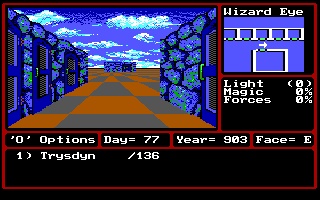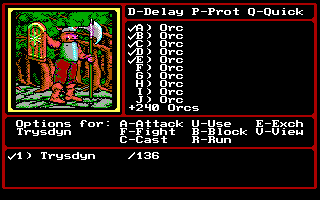2018-10-12: Might & Magic: Book Two - MORE, BIGGER, BETTER
Usually I reserve doing post-game write-ups for uh... after I finish the game. M&M2 though is so expansive, so long, and has so much stuff going on in it that I feel more than one post is warranted; especially since I feel like I just passed a point in which the game will significantly change.
Hot on the heels of my M&M1 playthru, I fired up M&M2. In retrospect, I probably should have taken a break between games because M&M2 is quite a bit to chew on by itself, nevermind as part of a double header, or even a trilogy like I had originally intended. The plan to staple on M&M3 immediately to the end of this playthru is quite dead at this point I assure you. I'm having a blast, but two M&M games back to back is probably enough for awhile. In any case, I imported my party and they got downgraded to level 7, with 20 in every stat, and all their gear stripped. Still, at least this means I didn't need to spend hours rolling (or hacking my characters to have fair stats, like a brat). I also got to skip the horrible level 1-5 grind that blocks you from getting Fly and multi-target spells that makes the beginning of Book One a drudgery.
The downside of doing a straight import is I had no opportunity to experience Book Two's new classes: Barbarian and Ninja. I elected to instead grab the first two hirelings of the appropriate classes I could find and use them to flesh out my team. That's a new feature of Book Two, by the by: hirelings. They're pre-generated characters that you have to rescue in the world of CRON before you can use them. Once freed, they can be drafted into your party like any other character. They are healed for free and level up for free, but cost a daily gold allowance to maintain, so it evens out. Honestly, gold is so plentiful in Book Two that I've yet to notice their presence even leaving a mark in my coffers. In any case, with two of the expanded eight-member party roster forced to be hirelings, there was no reason not to run a party of one of every class.
Right from the start, Book Two has some major, major changes and QoL improvements. First, the first person view is an order of magnitude more bright, vibrant, and populated. Compared to Book One's black fields with sometimes a tree or rock wall in them, Book Two is a masterpiece. Additionally, your party and their general status is always visible. No more having to constantly hit Q to view your HP; it's all right on screen. On top of those two massive improvements, Book Two also includes an automap. Upon giving any member of your party the Cartography skill, any tile you step on will be mapped in an automap that you can access by pressing M. This completely obsoletes the Location spell from Book One, though as a result you now are no longer told what field you are in when you check you location. If the automap isn't in-your-face enough, two new Sorcerer spells will also display the map right in your HUD, letting you see surrounding tiles even if you haven't stepped on them. It all comes together to make Book Two's default HUD very functional and usable, as opposed to Book One's uh... nothing.
Combat has received a massive facelift too: enemies remain visible in battle, and even animate when text isn't printing. Most of these animations are two or three frames and pretty janky, but it's an endearing kind of janky. Of course your party status is once again visible in battle. Aside from that battle works almost identically to Book One, with the major exception of the fact that enemy counts are practically unbounded now. There's even a few events that'll put you face to face with literally hundreds of cannon fodder foes. Fortunately there's now spells that hit everything, instead of being limited to 4, or 10 but only if outdoors. On the minus side, they're endgame spells.
Finally the biggest change to Book Two is its sense of scale. To quote a stream viewer: "Book Two is 'MORE BIGGER BETTER' but sometimes isn't better". The world is the same 5x4 16x16 grid, but there's a massive expansion to the number and depth of the dungeons. Castles from Book One are still present, but each castle now has its own multiple floor dungeon in addition to the castle itself. Each town has its own one-floor dungeon. Then each 16x16 grid on the surface world has multiple dungeons that are either plot required or auxiliary entirely. On top of that, you also gain the ability to time travel, possibly adding yet another dimension to the size of the game world (I haven't utilized time travel yet so I don't know). To offset the growth of the world, Book Two changes its overworld up from using "razor walls" (walls between tiles) to full tile obstacles. Instead of two tiles having a wall between them, walls an be forests, mountains, etc. These can be completely passable, or passable only with a specific skill. As such, the entire overworld can be walked across in a straight line with the right combination of skills and buffs. There are no walls. This actually makes the overworld feel smaller, even though it is the exact same size.
In addition to the size of the world, Book Two suffers some of the most massive stat inflation known to man. Seriously, this puts Burning Crusade to shame. In Book One, you spent most of the game with vaguely DnD stats. 16 was good, 20-25 was super-human, and then toward the end you could inflate to 50 as a ridiculous overblown max if you wanted to grind quests over and over. Gear came with pluses... +1, +3 maybe. I finished Book One at level 14, a reasonable level to finish a DnD adventure. Book Two quickly inflates your stats to 50 as a baseline, with temporary buffs taking you to 200. Pluses on gear quickly hit +4 or +5 and swell from there: my record so far is a +12 katana. You can't even reliably begin the main quest until level 15 or 20; I've heard stories of people finishing in the 70s. Breaking 100 damage with an attack in Book One was a major milestone; in Book Two I've hit for 500 and I'm just getting started.
As for the two new classes: they're both basically "Like X but Y". Barbarian is like a Knight, but with more HP and less armor. Ninja is like a Robber, but more combat power and less thievery. Thievery is now a visible stat instead of just having to hope the picks and keys you equip are actually improving your chance to pick locks. At the same level, my Robber is at 90% thievery and my Ninja is at 35%. I definitely wouldn't want only a Ninja for my larceny needs! However Ninjas also have the ability to equip some neat Ninja-only weapons, and have an enhanced critical hit opportunity. I don't know, honestly I think the Robber is just better; if I wasn't limiting myself to one of every class, I'd probably replace the Ninja with another Knight or another Sorcerer. The Barbarian functions in combat exactly like a Knight, except he takes more damage but has more HP to compensate. I tend to prefer armor over HP: less drain on my healers.
With all this improvement and new content however, there's three glaring negatives:
The devs seem to have felt like magic was too strong in Book One, and in a way it was. Heck, in every dungeon crawler magic tends to outshine physical combat once the foes start coming in droves. To compensate for this, Book Two throws a ton of dirty tricks at you to limit your use of magic. Anti-magic squares are common, and frequently come hand and hand with out of depth encounters. A lot of pre-generated molds come with foes that either instantly zero out your entire party's spell points, or lower your spell level; neither condition can be repaired in combat, so either one instantly removes your ability to cast for the rest of the fight. Finally most difficult foes come with magic resistance that can lower the effectiveness of offensive magic to almost nothing. Later on when you have 3-6 physical fighters who can hit for hundreds of damage it's an annoyance; earlier any of these can be a death sentence.
Also, for some reason completely beyond me, the devs decided to implement a new system of immunities. Normally you'd expect a monster to be immune to physical or magic (which they can be), or immune to elements, or possibly just unable to be attacked by PCs of a specific alignment but no. What Book Two implements is immunity to a specific gender. What makes even less sense is that a lot of these gender-immune enemies appear early in the game, when you have even fewer tools to deal with them. Some of them make sense, like succubi style foes being immune to anyone male doing direct damage to them, but some of them are just senseless. For example, most undead seem to be immune to men or women, chosen at random. You can get around this with multi-target spells, or just having a 4/4 split of characters in your party, but in my early game I had six PCs, five of which were female, and it got to be quite tiresome to randomly have foes immune to 5/6th of my party.
With the increased focus on gender as an important gameplay choice, the devs also turned their sights to alignment. In Book One, alignment was almost entirely irrelevant. It mattered for one quest, and a few pieces of gear. In Book Two it's... well still irrelevant, but made to appear less so via the super annoying mechanic of alignment-based gear. Any piece of equipment that drops with a plus can be locked to one of the three alignments. I've found through my playtime so far that if the item is an upgrade, it's the wrong alignment. Constantly. I think I've seen "WRONG ALIGNMENT!" more often than I've seen upgrades. According to one viewer, an item is statistically 50% likely to be unequippable due to alignment (since each alignment is equally likely to appear as is unaligned). I'd chosen to just roll all Neutral characters, which means half of all equipment is just sell trash, no matter how good it is. Perhaps I should change this arrangement.
With those three quibbles aside, I'm still having an amazing time with Book Two. All three of those problems become manageable as you grow; they're mostly just massive annoyances in the beginning when your toolbox for dealing with problems is shallow.
And like that I've already rambled on for about 10 paragraphs about just how Book Two differs from Book One, without even getting into my exploits. Perhaps we'll close this one and I'll continue in another post later.
Edit: and so I did, two additional write-ups to make this the game with the most ranting I've done on one subject.
tags: might_and_magic, rpg, game_writeup

